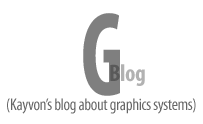For those interested, I've placed our HPG09 paper, Data-parallel Rasterization of Micropolygons with Defocus and Motion Blur, online on the Stanford Graphics Lab pages. It was surprisingly how tricky this problem can be, and, as it's clear from the paper, there's still room for improvement in this area. Look for more micropolygon-related papers to come (we hope).
One of the major research goals at Stanford right now is the design of a real time micropolygon rendering pipeline. There's a lot of recent and interesting work out there on implementing REYES-like algorithms on existing GPUs (see the RenderAnts folks, Anjul Patney's tessellation work, and NVIDIA's upcoming tech demos at SIGGRAPH). Our interest is not necessarily in implementing REYES; there are a lot of merits to the existing graphics pipeline. Rather, we're trying to determine how a real-time graphics pipeline, such as D3D11, (as well as corresponding future GPU architectures), should evolve to efficiently accommodate micropolygon workloads. At the Beyond Programmable Shading II course at SIGGRAPH 2009, I'll be getting the chance to talk a bit about what those pipeline changes might be, and what we (and the rest of the field) have learned about building an efficient real-time micropolygon rendering pipeline. Also, in the morning session of the course I will give an extended version of last year's GPU architecture talk: From Shader Code to a Teraflop: How a GPU Core Works.
HPG09 Paper abstract: Current GPUs rasterize micropolygons (polygons approximately one pixel in size) inefficiently. We design and analyze the costs of three alternative data-parallel algorithms for rasterizing micropolygon workloads for the real-time domain. First, we demonstrate that efficient micropolygon rasterization requires parallelism across many polygons, not just within a single polygon. Second, we produce a data-parallel implementation of an existing stochastic rasterization algorithm by Pixar, which is able to produce motion blur and depth-of-field effects. Third, we provide an algorithm that leverages interleaved sampling for motion blur and camera defocus. This algorithm outperforms Pixar's algorithm when rendering objects undergoing moderate defocus or high motion and has the added benefit of predictable performance.
Friday, July 24, 2009
Subscribe to:
Posts (Atom)
